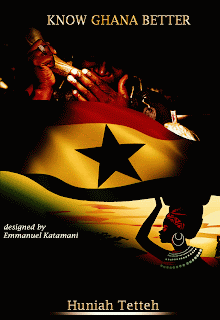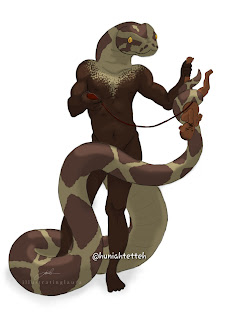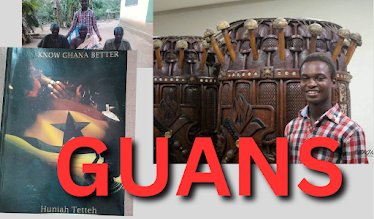THE NAWURI PEOPLE OF GHANA
(Know Ghana Better 2021)
The people of Nawuri and Atsode migrated with the Krachi and Ntsumburun from the Akuapem-Larteh and Akuapem-Kyripon areas. Due to the mass migration of the Guans from Akuapem as a result of Akan oppression especially from the Akwamu, the Larteh and Kyripon communities became very few.
As stated earlier, the Nawuri together with the Ntsumburun, Atsode and
Krachi people moved in families of clans with each clan head or “Ebusua mo-enum”
as their leader. Among the Nawuri, they were under the leadership of their
family head Owura Koronkpau. They migrated as well when the Krachi and Ntsumburun
left. This is because the Ntsumburun and Kete-Krachi oral history states
clearly that when they got to the Kwahu forest, they were there with some Guan
families with whom they migrated together to their present settlements.
Owura Koromkpau and his people got to Nkombi in the Bono East region.
They further continued with the Krachi to the present day Oti region and made
settlements. The Nawuris are said to be great hunters so perhaps hunting got
them to their present day Northern Region although their territories continue
from Ntsumburun and Krachi lands. They got to the upper parts of the Krachi-Ntsumburun
lands by crossing the Oti and Dambai where they settled for convenience sake.
One Prof. Yane made it quite clear to me as I
had earlier indicated in the topic “The Ntsumburun People” that, the Nawuris
settled at a place within Kwame-Danso, an Ntsumburun territory. Thus, the
forest in which they once settled is presently known as Nawuri Kepor and it is
till date around Kwame-Danso.
Nawuri comes from the Guan language meaning “Ana wuri wuri” which means
“the people who move in groups.” Nawuri oral history further continues that
when they made settlement, a group of people who knew the arts of magic were
seen coming down from the skies with chains holding them. It was a family head
with his members who were practitioners of African magic.
They descended at the Nawuri lands of Balai and the chains that held
them when they flew to Nawuri is till date with the Chief-priest of Balai and
anytime they celebrate their Yam Festival (Ejo Gigyi), it is brought out and
the necessary rites are performed to venerate it. The Nawuri also celebrate the
Guinea corn Festival also called Geyugyi. Nawuris are mostly Christians and a
few of them are Muslims unlike the Gonjas who are mostly Muslims.
It is also good to note that the Kyripons and
Lartehs at Okuapeman also celebrate the Ejwegyi which is their “Yam festival.”
The Nawuri kingdom has clans but the clans do not apply to all Nawuri
communities. They vary from one community to the other. The Nawuri people extend
from Kpandai, Balai, Bladjai, Kabonwule, Katiejeli, Kitare, Idisane (Idisane
means it is there for us), Awuratu, Surugu, Lesani, Nkankyina, Bayim, Dodoaye
(Dodope), Njare, Kpassa, Kpakpa, and few others.
Kpandai is the capital of Nawuri land and the name Kpandai is said to
have originated from “I am going to my senior brother” which is said as “Nkpɛ
ndayi” and it has been modified to Kpandai.
Kitare is originally “Antare.” Antare was one of the Nawuri leaders
whose name has been corrupted overtime to Kitare.
Katiegyeli history goes that there was a farmer who used to always hang
his hoe on a tree thus in Nawuri they would normally say “Katie jan oyui su” which simply means “a hoe hanging on a tree.” Katiejanoyuisu was mispronounced
and with time became “Katijanyu” then Katiegyenyu” and with time “Katiegyenlu” then
Katiegyeli. Katiegyeli is a Nawuri community bordered to the east by Bladjai
and Kabonwule; the north by Nkantina; the south by the Ntsumburun of Banda and
the Wa stream; the west by Kenyinkpa. Katiegyeli has five clans and they are
the Takare clan whose first chief is the Katiegyeliwura Nana Agyabaso I and he
belonged to the Takare clan. The other clans of Katiegyeli are Nkani, Nyimaye, Tosuai
and Okupe.
THE STORY OF BLADJAI:
Nawuri-Bladjai is one of the principal Nawuri communities and a very old
community as such. It traditionally has three clans and they are the primary
Bladjai clan (also called the Prenpren clan) which was originally referred to
by the whites as the Plain-plain clan. Those who belong to the Prenpren clan
are believed to be truthful thus the whites used to call them the Plain-plain
people which has further been corrupted to Prenpren by native Nawuri speakers.
The original name of the clan was Bladjai but then the name has been changed to
Prenpren and “Bladjai” is now the name of the community.
The Dortilai clan who are mainly farmers thus, Dortilai which simply
means the “Farmers” is the second clan of Bladjai. Later the Ankeamo clan who
were originally the Dzorokpangabi from a village in Togo according to oral
sources joined in. Oral history furthers that the Dzorokpanga people came from
Togo to meet Nana Nkpewiase with their god Namboala. Then the members of the
Prenpren clan had their native god Prenpren-Bewuraja likewise the Dortilai who
had their native Nantsuli god. Their native gods were not destructive gods but
very protective but then the god of the Dzorokpanga could be destructive; so
there were talks among Nana Nkpewiase I of Prenpren, the Dortilai leader and
the Dzorokpanga people as their Namboala god would have no place to stay with
the Prenpren and Dortilai people.
A consensus was reached and the Dzorokpanga were to move out of town but
still be part of the Bladjai people. Now it is very interesting not to forget
that the Guans are peace loving people and they abhor bloodshed so they embrace
everyone. The Dzorokpanga people were first taken to a place between Bladjai
and Nkankyina called Getekyeweso which
was a very stony area and not suitable for farming. Getekyeweso simply means
“exposed to the sun” in Guan. They came back to Nana Nkpewiase I with the plea
that they have to farm so they would prefer a place to “farm and eat” and if
they could be given a fertile land and so their settlement was changed to a
place called “Dogyi” where “Dɔ” is Guan and Akan for weed/farm” and “gyi is
Guan for eat” thus Dogyi simply means “farm and eat.”
Later, they demanded a place for fishing and they were made to fish in a
river that Nana Nkpewiase used to fish in called Nkpewiase-gepatai which was
changed to “Ɔfɔ gepatai” meaning “the strangers’ stream” in Nawuri and the name
has remained till date. The name Dzorokpanga was later changed to Ankeamo thus the Ankeamo clan. Ankeamo
means “we are looking at them.” It is furthered that when the Dzorokpanga
finally settled with the Guans, they did not want to break the rules of the
land so they would normally say let us look up to them and learn from them thus
the name Ankeamo.
Therefore, the three clans of Bladjai are now Prenpren, Dortilai and
Ankeamo. They have lived peacefully over the years ruled by several chiefs. In
Nawuri land, they traditionally did not install chiefs rather the oldest
persons of the land were made to govern aspects of Nawuri traditions and they
were called the Gedai-Obilisa. The Gedai-Obilisa performs functions like pouring
of libations, offering sacrifices to clan gods and performing other specific functions.
These rulers or better still chiefs have the title Nana and they include
§
Nana Nkpewiase I
§
Nana Sei II
§
Nana Olung III
§
Nana Aniwamne I
§
Nana Anafuntsor I
§ Nana Akwasai II popularly known as Agonga
§
Nana Aketanyi III
This has thus remained until 1991 after the Nawuri-Gonja conflict where
the Nawuri people began to install chiefs called the Owura after an agreement
was reached by all the Nawuri communities. So in Bladjai, the first chief to be
installed was Nana Ataamusum Aba I from the Dortilai clan who ruled from 1995
to 2013. He faced an opposition from the Ankeamo clan but then their contestant
whose father ruled Bladjai as Gedai-Obilisa; so the Ankeamo contestant was
rejected and Nana Ataamusum Aba I was installed as Bladjaiwura. Nana Ataamusum
Aba I was succeeded by Nana Gusekyor from the Ankeamo clan after which he was
succeeded by Bladjaiwura Nana Nkpewiase Nkpajator II from the Prenpren clan.
The installation of Nana Nkpajator Nkpewiase II was peacefully done but
then in September, a conflict was generated at Bladjai by the Ankeamo on the 14th
of September, 2017. The members of the Ankeamo clan claimed it is their turn
and not that of Prenpren without taking into consideration the rotatory nature
of the chieftaincy in Bladjai land. Libations were poured by the Prenpren clan
head which invoked the gods of the Prenpren clan making the armory of the
Ankeamo people seized and the cloth which bears their symbol of power rendering
them powerless and most of them were arrested and kept in Salaga prisons before
they were later taken to prisons in Kpandai and then to Tamale after which they
were made to sign bond of good behavior and thus peace was restored to Bladjai.
Bladjai comes from Akan that is “Bre na gyai”; history continues that
during the Asante conquest, they pursued the Guans after they got to the North
that is Ntsumburun, Nawuri, Atsode and Kete-Krachi so they comforted themselves
with the words “mu bre a, mu be gyai” so “bre na gyai” gradually became
Bladjai. Bladjai is bordered by Kabonwule, Kitare, Nkantina. It is also
bordered by Atsode-Kundube to the east and Nanumba to the north.
Awuratu in present day Oti Region are Nawuris
and they are part of the Bladjai territory. Awuratu comes from the Nawuri
language and it means “Awura tu” meaning “meeting of chiefs” in both Guan and
in Akan. Awuratu is under the Kpassa district of the Oti Region. They exhibit
the three clans of Bladjai: Prenpren, Dortilai and Ankeamo. Nana Okumonye I
ruled Awuratu as Awuratuwura and he was from the Prenpren clan and then Nana Akyeku
from the Ankeamo clan.
The Nawuris believe in the River Oti and she serves as a goddess to
them. Oti is called Naa lii in Nawuri. They have the Gekpankya dance which is
their ceremonial dance.
APPELATIONS OF THE BLADJAI CLANS AND THEIR
APPELATIONS
|
CLAN |
TOTEM |
APPELATION
(Nawuri) |
APPELATION
(English) |
|
Prenpren |
Lion (Kutuŋ) |
1.
Gemeŋtsɔ gebuja |
Small but powerful |
|
2.
Ɔyili benbe tuu
benbe |
Hunters that kill game from the Oti |
||
|
3.
Tinkpasa wuli sa
mogu wuletai mangyegejɔ |
The alligator may look seek but it’s very
strong |
||
|
Dortilai |
Crocodile (Ɔkalaŋ) |
1.
Aniwu gunun tsɔlin
ngbinii |
We saw meat and took away the okro |
|
2.
Sibelen tɔ kutun |
Strength of a lion |
||
|
Dzorokpaŋa |
The Dzorokpanga from history were not
originally Guans hence do not exhibit the Nawuri clan structure |
||
COMMON COURTESY IN NAWURI
|
GADꜪI |
NKYIWULA |
WORD |
RESPONSE |
|
Asundɛ? |
Alanfia bu tɔ! Awoo! |
How are you? |
I am fine! |
|
Fu sɔ alanfia? |
Nsɔ alanfia! |
Are you fine? |
I am fine! |
|
Ansuma! |
Awoo! Gɛrɛtsa! |
Good morning! |
Good morning! |
|
Antre! |
Sanga fu! / Saafa! |
Good afternoon! |
Good afternoon! |
|
Anula! |
Saafa! |
Good evening! |
Good evening! |
|
Nsɛgɛ su! |
Imanfu afuala! |
Thank you! |
Don’t mention! |
|
Nkulu fu ni! |
|
I beg you! |
|
|
Nsɛgɛ ba! |
Nsɛgɛ na tɛ! |
Welcome! |
Thank you! |
Nana Nkpajator Nkpewiase II, Blajaiwura of Nawuri; Nana Agyabaso I, Katiejeliwura of Nawuri; Nana Aniwamne
kwame Dapaah, clan head of Dortilai;
Nana Elibamoase – Prenpren Clan head of
Bladjai; Nana Benyinanile, the
Oldest lady in Bladjai as at 2019.








Comments
Post a Comment
Thank you! Gladly appreciate your feedback. You can also reach out personally via whatsapp or follow me on youtube/facebook Huniah Tetteh.